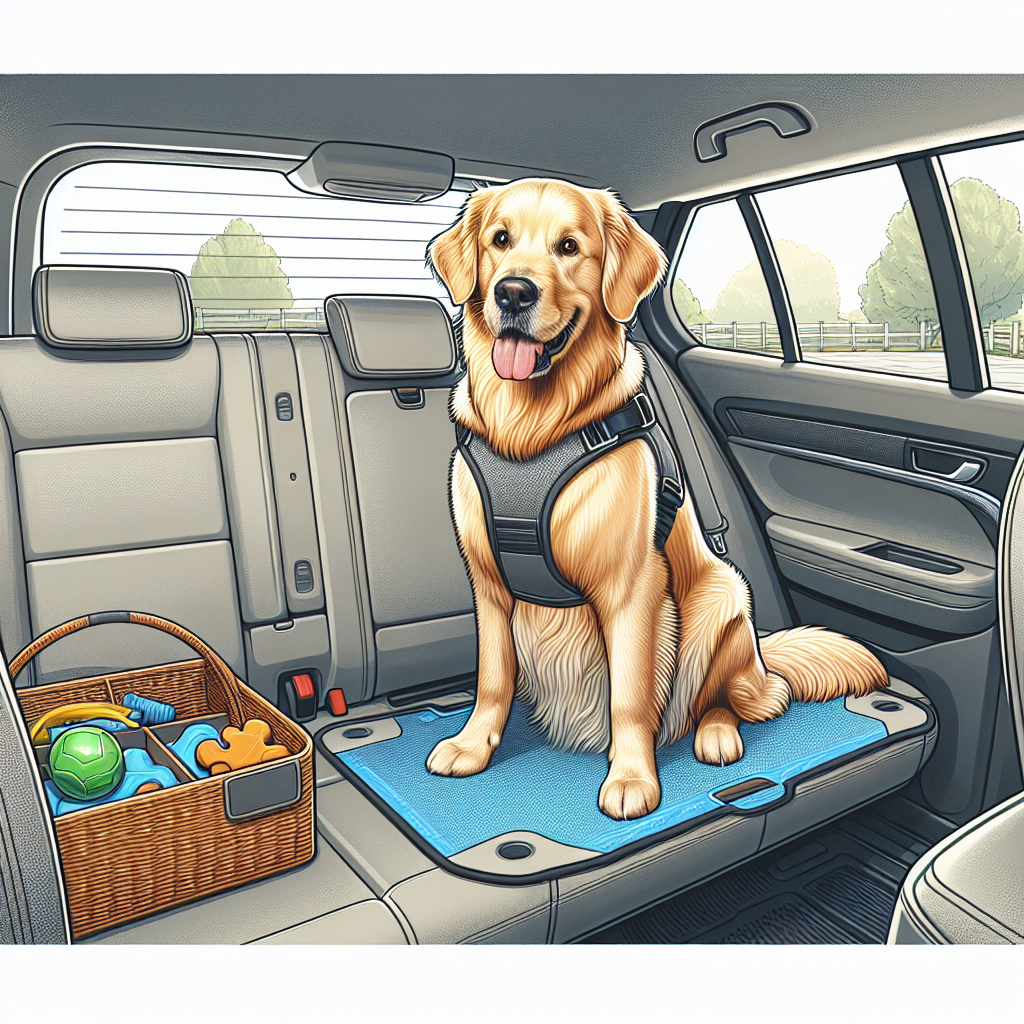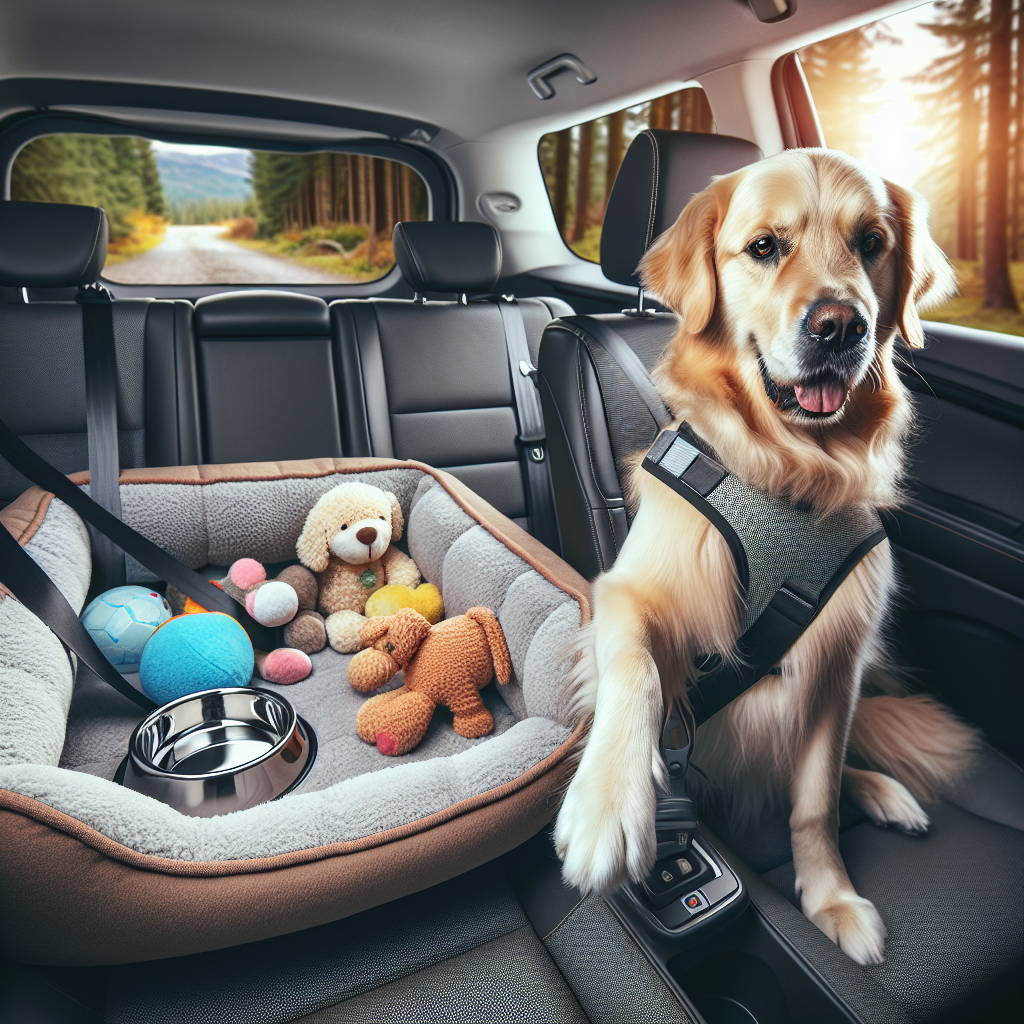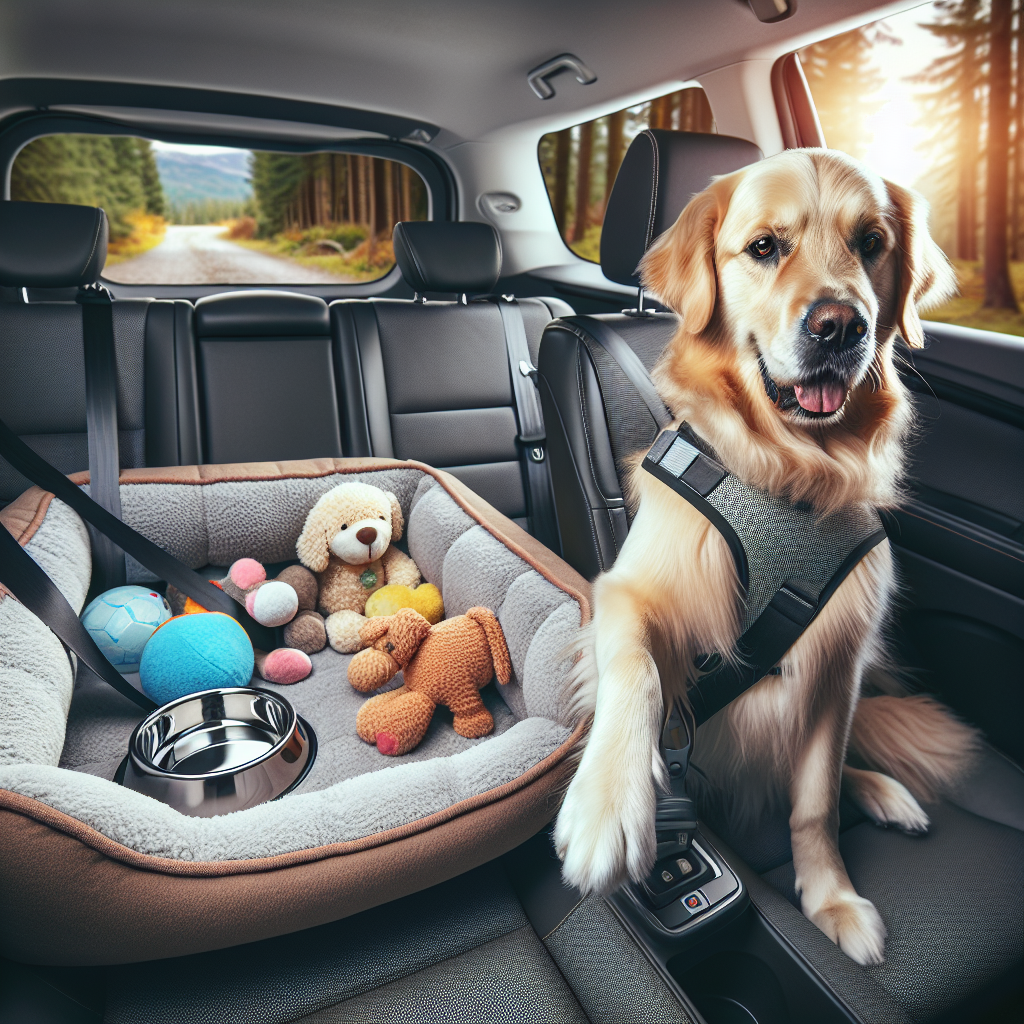Planning a road trip with your furry best friend? Look no further for essential tips on ensuring a safe and enjoyable journey for both you and your dog. From securing your dog in the car to keeping them comfortable and entertained, this article will provide you with all the information you need to make your car travel experience with your dog stress-free and fun. So pack your bags, buckle up, and get ready for a pawsome adventure with your canine companion!
Preparing Your Dog for Car Travel
Get your dog comfortable in the car
Before embarking on a road trip with your furry friend, it’s important to get them comfortable in the car. Start by introducing your dog to the vehicle in a calm and positive manner. Let them explore the car with the doors open and allow them to sniff around. Gradually, encourage them to jump into the car and reward them with treats and praise. This will help create a positive association with the car and alleviate any anxiety or fear they may have.
Take short practice drives
Once your dog feels comfortable being in the car, it’s time to take them on short practice drives. Begin with short trips around the block and gradually increase the duration over time. This will help your dog acclimate to the motion and feel of the car. Pay attention to their behavior during the drives and address any signs of discomfort or anxiety promptly.
Secure your dog with a seat belt or harness
It’s crucial to secure your dog while traveling in the car to ensure their safety. Use a seat belt or a harness specifically designed for dogs to restrain them during the journey. This will prevent them from roaming around the car and minimize the risk of injury in case of sudden stops or accidents. Make sure the seat belt or harness fits properly and is comfortable for your dog.
Consider using a crate
Another option for ensuring your dog’s safety during car travel is to use a crate. A crate provides a secure and familiar space for your dog, reducing their anxiety and preventing them from causing distractions. Choose a crate that is appropriate for your dog’s size and make sure it is well-ventilated and secure within the vehicle. Gradually introduce your dog to the crate by making it an inviting and comfortable place for them.
Safety Measures Inside the Car
Avoid traveling in the front seat
While your dog may enjoy being close to you, it’s safer for them to travel in the back seat or in the cargo area of the car. Traveling in the front seat can be dangerous for your dog, as airbags can pose a significant risk in case of an accident. Additionally, your dog may inadvertently interfere with your ability to drive by stepping on the pedals or distracting you.
Never let your dog stick its head out of the window
While it may seem fun for your dog to stick their head out of the window and feel the breeze, it poses significant risks. Your dog may be at risk of eye injuries from debris or insects, or even falling out of the window. It’s best to keep the windows closed or slightly open for ventilation, keeping your dog safely inside the car at all times.
Keep the windows slightly open for ventilation
Proper ventilation is important to ensure your dog’s comfort during car travel. While it’s crucial to keep the windows closed or only slightly open to prevent your dog from sticking its head out, it’s also essential to allow airflow inside the car. This will help regulate the temperature and keep your dog comfortable throughout the journey.
Do not leave your dog alone in a parked car
Leaving your dog alone in a parked car, even for a short period, can have disastrous consequences. Temperatures inside a car can rapidly rise or fall to dangerous levels, putting your dog at risk of heatstroke or hypothermia. Additionally, your dog may become anxious or distressed when left alone in an unfamiliar environment. Always make sure to bring your dog with you or arrange for someone to stay with them if you need to leave the vehicle.

Essential Items for Car Travel with Your Dog
Pack enough food and water
When traveling with your dog, it’s important to bring enough food and water for the duration of the journey. Familiarize yourself with your dog’s regular feeding schedule and portion sizes, and pack accordingly. Keep in mind that changes in routine and exercise during travel may affect your dog’s appetite, so be prepared for adjustments. Bring collapsible bowls or spill-proof water dispensers for easy feeding and hydration on-the-go.
Carry a leash and collar with identification tags
A leash and collar with identification tags are essential items to have when traveling with your dog. In unfamiliar environments, it’s important to have control over your dog and be able to safely restrain them when necessary. Make sure the collar fits properly and includes up-to-date identification tags with your dog’s name, your contact information, and any relevant medical information.
Bring waste bags and cleaning supplies
Being a responsible dog owner means being prepared to clean up after your dog. Pack an ample supply of waste bags to properly dispose of your dog’s waste during travel stops. Additionally, accidents can happen, so be sure to bring cleaning supplies such as pet-friendly stain removers and absorbent towels to quickly clean up any messes.
Include your dog’s favorite toys or blankets
To help keep your dog calm and comfortable during car travel, consider bringing their favorite toys or blankets. These familiar items can provide a sense of security and comfort in an unfamiliar environment. Toys can also help keep your dog entertained and prevent them from becoming bored or anxious during the journey.
Frequent Breaks and Exercise
Plan for regular pit stops
Just like humans, dogs need regular breaks during long car journeys. Plan for frequent pit stops to allow your dog to stretch their legs, relieve themselves, and take a break from the car’s confined space. Research and locate pet-friendly rest areas or parks along your route, ensuring you have ample opportunities for breaks.
Allow your dog to stretch and relieve itself
When you make pit stops, give your dog ample time to stretch and relieve itself. Dogs may become restless if they are confined for long periods, so giving them the opportunity to move around and stretch their muscles is important for their well-being. Bring along a leash to safely walk your dog during these breaks.
Take short walks during breaks
In addition to allowing your dog to stretch, incorporating short walks into your pit stops is beneficial. Walking provides mental stimulation and helps release pent-up energy, making the car ride more manageable for your dog. Choose safe and quiet areas for walks, and always keep your dog on a leash to ensure their safety.
Avoid strenuous exercise before and during car travel
While exercise is important for your dog’s overall well-being, it’s best to avoid strenuous activities before and during car travel. Intense exercise right before a car ride may leave your dog exhausted, which could lead to discomfort during the journey. Additionally, vigorous exercise during travel breaks may increase the risk of injury or heatstroke, especially in hot weather. Stick to light to moderate exercise to keep your dog comfortable and safe.

Health and Vaccination Considerations
Ensure your dog is up-to-date on vaccinations
Before embarking on any journey with your dog, it’s crucial to ensure they are up-to-date on all necessary vaccinations. This will help protect them from potentially dangerous diseases they may encounter along the way. Consult with your veterinarian to make sure your dog’s vaccinations are current and obtain any necessary documentation to carry with you during travel.
Bring necessary medications and first aid supplies
If your dog requires any medications, be sure to bring an ample supply for the duration of the journey. It’s also important to pack a basic first aid kit tailored to your dog’s needs. Include items such as bandages, antiseptic wipes, tweezers for removing ticks or splinters, and any medication specific to your dog’s health conditions. This will ensure you are prepared to handle any minor injuries or illnesses that may arise on the road.
Have contact information for local veterinarians
While we hope it never comes to this, emergencies can happen during travel, and having contact information for local veterinarians along your route is essential. Research and make note of veterinary clinics or hospitals that offer emergency services. Store their contact information in your phone and keep a hard copy in your car’s emergency kit.
Consider getting a health certificate for long trips
If you’re planning a long-distance journey with your dog, it may be necessary to obtain a health certificate. A health certificate is a document issued by a veterinarian that certifies your dog is healthy and fit to travel. Some airlines or destinations require this documentation, so check the specific requirements for your travel circumstances. Even if it’s not a requirement, having a health certificate can provide peace of mind and ensure your dog’s overall well-being.
Avoiding Stress and Anxiety
Create a comfortable and familiar environment in the car
To help alleviate stress and anxiety for your dog during car travel, create a comfortable and familiar environment inside the car. Place their favorite blanket or bed in a designated area and surround them with familiar scents. This will help create a sense of security and make them feel more at ease. Additionally, consider using a crate or a dog-specific seat cover to create a defined and secure space for your dog.
Play soothing music or use calming pheromones
Music can have a calming effect on both humans and dogs. Choose soothing music or specially designed playlists for dogs to help create a relaxed atmosphere in the car. Another option is to use calming pheromones, such as sprays or plug-in diffusers, to help reduce your dog’s anxiety. Consult with your veterinarian for recommendations on suitable products.
Use anxiety-reducing products or natural remedies
In addition to music and pheromones, there are various anxiety-reducing products and natural remedies available to help calm your dog during car travel. These may include anxiety wraps, herbal supplements, or CBD products. It’s important to consult with your veterinarian before using any new products to ensure they are safe and suitable for your dog.
Consult your veterinarian for severe anxiety issues
If your dog experiences severe anxiety or exhibits signs of extreme stress during car travel, it’s best to consult with your veterinarian. They can provide professional guidance and may recommend behavior modification techniques or prescribe medication to help manage your dog’s anxiety. Remember, the well-being and comfort of your dog should always be a top priority.
Protecting Your Dog from Extreme Temperatures
Avoid leaving your dog in a hot car
This cannot be emphasized enough – never leave your dog alone in a parked car, especially in hot weather. The temperature inside a parked car can rise rapidly, even with the windows cracked open, leading to heat exhaustion or even death. If you need to make a stop where your dog cannot accompany you, ensure you have a plan in place to keep them cool and safe.
Prevent your dog from getting too cold
Likewise, it’s important to protect your dog from extreme cold temperatures. Dogs are susceptible to hypothermia and frostbite, especially in freezing weather conditions. If traveling in cold climates, make sure your dog has an extra layer of insulation, such as a doggy sweater or jacket, and avoid excessively long exposure to cold temperatures. Use heated blankets or beds designed for dogs to provide additional warmth if necessary.
Use sunshades or window screens to block direct sunlight
Direct sunlight can quickly heat up the interior of your car, making it uncomfortable and potentially dangerous for your dog. Use sunshades or window screens to block the sun’s rays and keep the car cooler. This will help regulate the temperature and protect your dog from overheating.
Consider packing a collapsible water bowl for hydration
Hydration is crucial for your dog’s well-being during car travel, especially in warm weather. Pack a collapsible water bowl and bring along fresh water for your dog to drink at regular intervals. This will help them stay hydrated and prevent the risk of dehydration. Always ensure water is readily available for your dog during the journey.
Training and Behavior Tips
Teach your dog to stay calm during car travel
Training your dog to stay calm during car travel is essential for a stress-free journey. Gradually introduce them to the car and practice short drives to help them become accustomed to the motion and environment. Reward calm behavior with treats and praise to reinforce positive associations. If your dog exhibits signs of anxiety or stress, consult with a professional dog trainer for guidance on behavior modification techniques.
Reward good behavior with treats and praise
Positive reinforcement is a powerful tool when it comes to training your dog. Reward good behavior, such as staying calm and relaxed in the car, with treats and praise. This will help your dog associate car travel with positive experiences and encourage them to repeat the desired behavior.
Address car sickness or anxiety with positive reinforcement
Some dogs may experience car sickness or anxiety during travel. To address car sickness, consider feeding your dog a light meal a few hours before the journey and avoid feeding them in a moving car. For anxiety, use positive reinforcement techniques and gradually desensitize your dog to the car environment. Consult with your veterinarian for additional advice or medication options if necessary.
Use desensitization techniques for fearful dogs
If your dog exhibits fear or phobia towards car travel, desensitization techniques can be helpful. Start by gradually exposing your dog to the car in a controlled and positive manner. This may involve simply sitting in the parked car with your dog, gradually moving on to short drives. Be patient and go at your dog’s pace, rewarding and praising them for any signs of progress.
Legal Requirements and Travel Regulations
Check local laws regarding restraining pets in vehicles
Before hitting the road with your dog, familiarize yourself with the local laws and regulations regarding restraining pets in vehicles. Some states or countries may require dogs to be restrained with a seat belt, harness, or in a crate while traveling. Failure to comply with these laws can result in fines or other penalties, so ensure you are aware of and follow the rules set forth for pet travel.
Find out if you need a dog travel harness or carrier
In line with local laws, determine if you need a specific dog travel harness or carrier for your journey. These devices are designed to keep your dog safely restrained while in the vehicle. Check with your local authorities or pet travel organizations for recommended products that meet safety standards.
Research specific rules for each destination or state
If you are traveling across state lines or to a different country, it’s important to research and understand the specific rules and regulations for pets at your destination. Some states or countries have additional requirements for entry, such as health certificates, vaccination records, or quarantine periods. Stay informed and ensure you have all the necessary documentation and preparations in place to comply with the local regulations.
Adhere to quarantine or documentation requirements
In some cases, traveling with pets may require compliance with quarantine or documentation requirements. This is especially common when traveling internationally or to areas with specific disease control measures. Familiarize yourself with the requirements of your destination and take the necessary steps to ensure your dog meets these criteria. Failure to comply may result in denial of entry or additional complications during your trip.
Emergency Preparedness and Safety
Have an emergency kit with essential supplies
Being prepared for emergencies is crucial when traveling with your dog. Pack an emergency kit that includes essential supplies such as a pet first aid manual, gauze pads, adhesive tape, tweezers, and any necessary medications for your dog. Additionally, include items like a flashlight, batteries, and a thermal blanket. Having these supplies readily available can help you handle minor injuries or temporary setbacks while on the road.
Know the nearest animal hospitals along your route
Before starting your journey, research and note down the locations of the nearest animal hospitals or veterinary clinics along your route. In case of any medical emergencies or issues that require professional attention, you’ll have this information readily available. Save their contact numbers in your phone and keep a hard copy in your car’s emergency kit.
Keep a pet first aid manual in the car
A pet first aid manual is a valuable resource that provides guidance on how to handle common emergency situations and administer basic first aid to your dog. Keep a copy in your car’s glove compartment or in your emergency kit for quick and easy reference. This can be a lifesaver in situations where professional help may be delayed or unavailable.
Prepare a list of emergency contacts
Have a list of emergency contacts ready, including your regular veterinarian, the nearest animal hospitals, and any local animal control or rescue organizations. This list should also include your own contact information, as well as that of a trusted family member or friend who can assist in case of an emergency. Keep a printed copy of this list in your car for easy access.
By following these comprehensive tips, you can ensure a safe and enjoyable car travel experience for both you and your beloved four-legged companion. Preparation, proper precautions, and a little extra care will go a long way in making your journey stress-free and memorable. Happy travels with your furry friend!

